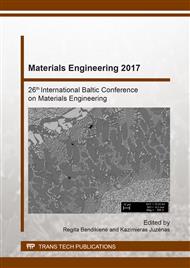p.207
p.212
p.219
p.224
p.229
p.234
p.243
p.248
p.253
Development of Impact Energy Distribution of Various Abrasives during Cyclic Impact/Abrasion Testing
Abstract:
In heavy industries like mining or steel production vast amounts of loose materials need to be transported, relocated or otherwise processed. During these routines severe stresses are applied on heavy machinery components such as excavator grabs and clamshells, which ultimately lead to excessive wear. The dominant wear mechanisms under such conditions are impact and abrasion. The focus of this paper is to investigate the fracture behaviour of various abrasives as experienced under real application in the steel industry. Breaking events of abrasive particles affect the impact energies on tool equipment. The Cyclic Impact/Abrasion Test rig (CIAT) was applied to investigate the stability and fracture behaviour of the abrasives. Rotating counter bodies made of martensitic quenched and tempered steel were used to generate impact events on loose abrasive particles. After certain time intervals the abrasives were screened and particle size fractions documented. Impact energy is strongly dependent on size and density, as well as fragility and cracking of particles. As fracturing events diminish particle dimensions and shift size distributions to lower size fractions, each abrasive showed a distinctive impact energy distribution over the course of the test duration. Impact energy distributions of abrasives were correlated to wear rates of the steel samples for each abrasive used. The results indicate a distinct behaviour of each abrasive, yielding certain impact energy distributions. Depending on processing specific abrasive goods in actual applications, impact energies and associated wear loss can differ significantly.
Info:
Periodical:
Pages:
234-242
Citation:
Online since:
October 2017
Authors:
Keywords:
Price:
Сopyright:
© 2017 Trans Tech Publications Ltd. All Rights Reserved
Share:
Citation:


